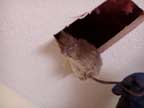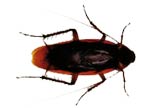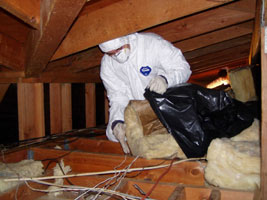|
Call toll free 877-4ABOLISH
877-422-6547
Bees
| Rats | Pigeons | Bats | Swallows
| Animal Trapping| Dead animal
Ants| Cockroaches | Fleas | Spiders | Pill bugs| Decontamination
 Bees:The
most common stinging bee in California is the honey bee. It was introduced
into this country from Europe in the 17th century. Its stinger,
which resembles a hypodermic needle with barbs, is used to inject
a mixture of alkali venom and acid into the skin. The alkali venom
contains several kinds of proteins and enzymes which are believed
to cause allergic reactions of varying degrees in humans. We provide
bee control services such as bee extermination and bee hive removal.
Leaving the Honey comb will result in future and immediate problems. Bees:The
most common stinging bee in California is the honey bee. It was introduced
into this country from Europe in the 17th century. Its stinger,
which resembles a hypodermic needle with barbs, is used to inject
a mixture of alkali venom and acid into the skin. The alkali venom
contains several kinds of proteins and enzymes which are believed
to cause allergic reactions of varying degrees in humans. We provide
bee control services such as bee extermination and bee hive removal.
Leaving the Honey comb will result in future and immediate problems.
Top
 Rats:The
fact about rats is that they are everywhere and not easy to control,
unless you are a professional. Specifications for rats can vary.
The length of an average rat is from 6-18 inches that's including
their tail. Roof rats tend to be charcoal gray in color as compared
to your sewer rat which is a brownish tan. Their diet consists of
eating almost everything, its not much of a diet. They consume ½
to 2oz of liquid a day. These are nocturnal creatures they eat and
drink under the cover of darkness. They are loud and gnaw at anything
they can, rats have been known to cause electrical fires in homes
by exposed electrical wires in attics. Rats are the cause of much
damage and carriers of parasites and diseases. Rats:The
fact about rats is that they are everywhere and not easy to control,
unless you are a professional. Specifications for rats can vary.
The length of an average rat is from 6-18 inches that's including
their tail. Roof rats tend to be charcoal gray in color as compared
to your sewer rat which is a brownish tan. Their diet consists of
eating almost everything, its not much of a diet. They consume ½
to 2oz of liquid a day. These are nocturnal creatures they eat and
drink under the cover of darkness. They are loud and gnaw at anything
they can, rats have been known to cause electrical fires in homes
by exposed electrical wires in attics. Rats are the cause of much
damage and carriers of parasites and diseases.
Top
 Pigeons: Pigeons:
Pigeons mate for life and rear their broods together, although if
one dies the other will take a new mate. Once the simple nest is
built, the female lays an egg and then another a day or so later.
The incubation period for common pigeons is 17 to 19 days. The female
sits on the egg from late afternoon through the night until about
10AM. The male then takes over and does the day shift. Once the
eggs hatch, both parents feed the young squabs. The first food is
pigeon milk or crop milk, a cheesy substance that appears in the
crops of the parents at hatching time and is fed for a week or so.
Then the adults start regurgitating partially digested grains for
the young. By the time the squabs are ready to fly, about 4 weeks,
the father is doing most of the feeding. The squabs are fed for
another week to 10 days after they are free-flying.
Top
 Bats: Bats:
Bats, while some species can be larger, bats are usually not much
bigger than a house mouse. The wingspan of the two most common Canadian
species, the little brown bat and the big brown bat, ranges from
8 to 14 inches. Bats will mate in fall or winter and the pups are
usually weaned in July or August. A few bat species will migrate
to the south when cold weather approaches while other species will
just move to caves, mines, and attics where the temperature does not
go below the freezing point. In some cases, the big brown bat will
even roost in buildings throughout the winter if conditions are
favorable, e.g. high humidity level and temperature above the freezing
point. Bats are loyal to their birthplaces, often returning to the
same roost site year after year. A bat can live more than 10 years.
Top
 Swallows: Swallows:
Swallows feed on insects and spend a large part of each day in the
air catching flies, beetles, and mosquitoes. Their long, pointed
wings give them great speed and maneuverability. Normally, swallows
are not seen on the ground except when collecting mud for their
nests. Most do not have musical voices but only twitter or squeak.
The cliff swallow is 5 to 6 inches in length and is the only square-tailed
swallow in California. In contrast, its long, deeply forked tail
distinguishes the barn swallow. The cliff swallow is also recognized
by its pale, orange-brown rump, white forehead, dark rust-colored
throat, and steel blue crown and back.
Top
 Animal
Trapping: Animal
Trapping:
We are an environmentally caring company and do not harm any animals
with our animal control methods. We trap raccoons, opossums, Pigeons,
and skunks. After the animal is humanely trapped, we release the
animals into the wild away from nearby towns or cities to deter
them from returning.
Top
 Dead
Animals : Dead
Animals :
Animals dying and decomposing is the natural part of the life cycle,
but for it to happen behind your walls or under your house is a nuisance.
Our Technicians are well trained in locating and removing the dead
animal. For dead animals in public please call your local animal control
center.
Top
 Carpenter
Ants : Carpenter
Ants :
These are among the larger (6-12 mm) ants in the United States.
Most are black but some are various shades of brown or red and black.
They usually have an evenly rounded thorax when viewed from the
side with a circle of tiny hairs on the tip of their abdomen. There
is only a single node in the thin-waisted petiole region. Carpenter
ants are social insects that usually nest in the center of rotting
trees or water damaged areas within wooden structures. These ants
feed on many foods. They do not feed on wood. The colonies are sometimes
located by sawdust-like debris dropped near their excavation.
At 900 F, their life cycle is completed in about 2 months Eggs hatch
in 24 days with the larval and pupal stages lasting 21 days.
Top

German
Cockroach :
This is the most common species of cockroach in the United States.
It is about 1/2" to 5/8" long as an adult. Nymphs and
adults of both sexes have two dark stripes behind the head. It prefers
to live in kitchens and bathrooms of homes and apartments, restaurants,
supermarkets, and hospitals. The Asian cockroach, Blattella asahinai,
is identical to the German cockroach in appearance and lives outdoors
in lawns and leaf litter.
Top
 American Cockroach: American Cockroach:
This cockroach is about 1 1/2" long as an adult. It is reddish-brown
with light markings behind the head. The cerci at the tip of the
abdomen are long and thin. It is commonly found in sewers and basements.
 Brown Cockroach: Brown Cockroach:
This cockroach is almost identical to the American cockroach in
appearance and is about 1 1/4" long as an adult. It is reddish-brown.
The cerci at the tip of the abdomen are stubby; whereas the American
cockroach has long, thin cerci. The brown cockroach is found outdoors.
It readily enters houses and is often called a palmetto bug.
 Oriental Cockroach: Oriental Cockroach:
It is about 1" long as an adult. It is shiny black and has
no distinctive markings. The male has wings that cover only about
3/4 of the abdomen; the female has only wing pads or lobes. This
cockroach is not commonly found in Florida. It is usually found
in damp basements, sewers, and crawl spaces beneath houses.
 Fleas: Fleas:
Adult fleas are flattened from side to side, dark colored, wingless
and have strongly developed legs. Their hind pair of legs are especially
adapted for jumping. They have sucking mouthparts used to siphon
out the blood of animals. Larvae are worm-like, legless and tan.
They feed on organic debris, dried blood and excrement from adult
fleas. Fleas usually bite humans where clothing fits tightly against
the body. Adult fleas can live for several weeks without a blood
meal. When found indoors, they are usually associated with pet dogs
or cats. Fleas can transmit several diseases including bubonic plague
and tularemia. They are also the carriers of a tapeworm which, in
the adult stage, is found in dogs and men.
These links will help you get ready.
Top
Flea tidbit - 1
Flea tidbit - 2
 Black
widow : Black
widow :
Female is one-half inch long; shiny black, with hourglass-shaped
red mark on underside of abdomen. Can be found almost anywhere,
indoors or out; prefer to build their nests close to the ground.
They eat insects trapped in webs made by females. Contrary to popular
belief, female is usually unsuccessful in any attempt to eat the
male after mating; 300 to 400 eggs are laid in silken cocoon, hatch
in about 10 days. Black widows are not aggressive, and will not
bite unless provoked. However, they are poisonous. If bitten, seek
medical attention; bites are rarely fatal.
Top
 Subterranean Termites:
Subterranean Termites:
Being in nearly every state, they are the most common pests injuring
structural timber. The winged forms are about 13 mm long and the
wingless workers and soldiers are 6 mm long. Termites develop from
eggs laid by primary or secondary reproductives. The nymphs proceed
through several molts during which the 4 different castes formed
are called workers, soldiers primary (winged) reproductives and
secondary (wingless) reproductives. Subterranean termite colonies
are usually located in the soil from which workers build mud tubes
to the wood upon which they must eat for food. We do not provide termite services
Top
 Pillbugs
(sowbugs): Pillbugs
(sowbugs):
Not more than three-fourths-inch long; thorax composed of seven
hard overlapping plates with seven pairs of legs; only pillbugs
are able to roll up into a ball. Pillbugs prefer moist locations;
found under objects on damp ground; mostly nocturnal; often invade
basements and first floors of houses. They feed on decaying vegetable
matter. Female gives birth to between 24 and 28 young per brood;
usually one to three generations a year; may live as long as two
years. Pillbugs and related sowbugs are the only crustaceans that
have become completely adapted to living their whole life on land.
Top
 Decontamination Decontamination
Our decontamination services includes Residential, commercial, and Industrial areas.
Bees
| Rats | Pigeons | Bats | Swallows
Ants| Cockroaches | Fleas | Spiders | Pillbugs
Call toll free 877-4ABOLISH
877-422-6547 |
![]()
![]()
![]()
 Dead
Animals :
Dead
Animals : 







 American Cockroach
American Cockroach Oriental Cockroach
Oriental Cockroach



